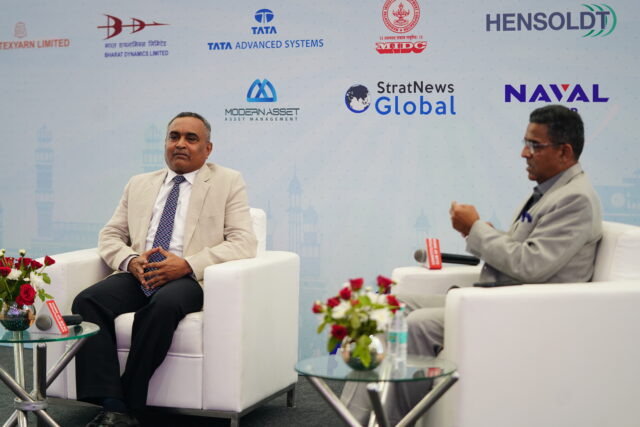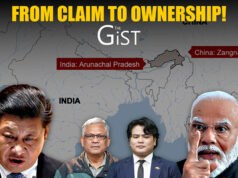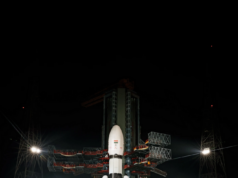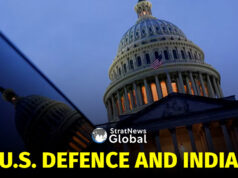NEW DELHI: The latest round of disengagement involving Indian and Chinese troops along the Line of Actual Control (LAC) in Eastern Ladakh notwithstanding, two more friction points still remain, says Army Chief General Manoj Pande. In a free-wheeling chat at the India Defence Conclave 2022 with founder and editor-in-chief of Bharat Shakti Nitin A. Gokhale, Gen. Pande spoke about a host of issues, including the key lessons learnt from the standoff along the LAC. Here’s the transcript of the entire interview:
Q: After 16 rounds of negotiations, the recent friction points between India and China have witnessed disengagement. What are we looking at and what is China looking at? What are the next steps on the border to reduce tension between the two countries?
A: While we have made progress in terms of disengagement from friction points that you just mentioned, we still have two friction points where we need to move forward and as we move forward by talking both at the military and at the diplomatic levels, I’m sure we’ll be able to find a resolution towards these two friction points. Our immediate aim is to disengage from these friction points before we look at the next step of, perhaps, de-escalation.
Q: Almost two and half years into the tension on the Ladakh border but that notwithstanding India has sort of mirrored the deployment over these past 26-27 months and has managed to stop the aggression by China having achieved the disengagement like you said this de-escalation is the next step perhaps after the friction points are taken care of but what lessons so far have you imbibed from the standoff that happened in Ladakh and how would you implement those lessons going forward?
A: The first and the foremost would be to maintain a high level of operational preparedness at all times, whatever be the situation. Second is the importance of infrastructure development, especially along our northern borders and when I mention northern borders, I am also referring to the area opposite Arunachal Pradesh or the eastern sector besides Ladakh. We also realized that there is adequate scope for Infusion of new technology and that is something which we need to leverage to enhance our ability to address challenges in the future. Fourth is that we need to develop our grey zone capabilities; we need to have a strategy to be able to effectively operate in the grey zone as well as build our capabilities in terms of what you require to operate in the grey zone. And the last one is our ability to mobilize troops and that relates to the first point which I mentioned that we need to maintain very high levels of operational preparedness.
Q: And you’re working towards improving all of them, I’m sure
A: Yes. Infrastructure is the first one which I mentioned. Let me tell you in the last two years, since May 2020, a significant amount of enhancement in our infrastructure has taken place especially in the context of Eastern Ladakh. We were able to create habitat for close to 35,000 of our troops in the form of 350-odd company modules. We had to induct our mechanized elements as well as additional artillery guns so we created covered accommodation, covered garages for almost 450-odd tanks and hay vehicles as well as about 350 artillery systems. These were some of the landmark achievements in a short span of two years.
Q: I remember going to eastern Arunachal Pradesh a year ago when you were the Eastern Army Commander, and one year before that to Ladakh. I think the logistics chain and the logistics effort of the Indian Army has stood the test of time or risen to the occasion. How are you going to take it further? You mentioned habitat, you mentioned the garages and the forward bases, logistics. In that respect what are the steps that you have taken?
A: One of the key issues that we are looking at is forward road connectivity because that would remain the mainstay of our ability to push in logistics as well as mobilize troops. Right now that is something we are focusing on and specially in the context of our eastern region where regarding infrastructure there’s a lot to be done. So we are focusing on creating (a) infrastructure, road connectivity right up to the border and (b) have inter-valley connectivity; that’s important bearing in mind the fact that most of these valleys have a single road axis leading up to the forward areas. We also need to have alternate road axis or alternate road connectivity should the main one get disrupted for some reason. The fourth aspect is bridges; there is a requirement to upgrade these bridges so that we are able to carry heavy carriers. Equally important we realized was to develop and build our aviation infrastructure in forward areas. I would say the strategic airlift for which you need larger runways but also equally important is tactical airlift wherein you need helipads in forward areas so that you are able to quickly move in additional troops in the areas if required. So that’s another area we are focusing on. To be able to protect ourselves, protect our assets against artillery fire, we have gone in a major way to having underground storage infrastructure both for ammunition and certain other logistics. These are three, four issues but I must also mention the tremendous support that we got from the Air Force, especially in the context of what happened in Eastern Ladakh. In a very short time, we were able to induct additional troops and heavy equipment which I thought was remarkable.
Q: It was a great synergized effort when we look back. Moving away from the immediate implementation of infrastructure development and otherwise, you mentioned grey zone challenges. In that respect, 5G, big data, cyber all that comes into the picture because we don’t know which way future wars will go. Last year we spoke about what happened in Armenia and Azerbaijan and now we are talking about the land war in Ukraine. We can’t really predict which way the war is going but what is the progress as far as induction of 5G big data, cyber and future technologies as far as the Indian Army is concerned?
A: Leveraging the niche technologies I would say has been one of the key pillars of our capability development programme. Towards this I will just highlight a few issues and let me start by what we are doing in the field of artificial intelligence. I’ll just name three, four projects in which we have made a fairly good headway. First, of course, is in terms of interpretation of satellite imageries—detection of objects, identification and comparison of satellite imageries that we get large numbers. Second is to be able to consolidate all the surveillance, reconnaissance and intelligence inputs and as you are aware we have a large number of sensors, we have ground-based sensors, we have aerial sensors; to fuse them so that you have a common intelligence picture is another area where we are banking heavily on artificial intelligence. In the context of what is happening in Jammu and Kashmir, we are also utilizing artificial intelligence for detecting suspicious vehicles; we have hooked on to the database of the regional transport organization so that any alien vehicle, any foreign vehicle or any sort of strange vehicle we are easily able to pick up. These are some of the projects in which we have made very good headway. Another area in terms of niche technology is the quantum key distribution and I’m sure some of your audience is aware that recently as part of the IDEX projects we were able to achieve 119 kilometres in a single hop in the area of Ladakh. That was a significant step and we are now building on it. In terms of unmanned ground vehicles, I think it was towards the end of the last year that we had in one of our field firing ranges almost 11 firms come up with about 27 solutions and this is what we are taking forward either in terms of detection of mines or for logistic drones and the like.
Q: And all of these technologies are coming from Indian companies, indigenous solutions?
A: Yes and a large number of them have been part of the innovation in defence excellence initiative of which I am sure in the earlier sessions you would have discussed.
Q: Yes, in fact we had a previous session but this is good to know because it is going to be the future technology. If Indian solution is available and if the Indian army inducts it after testing, which is quite stringent, our foreign friends who are here, foreign defence attaches and advisors, I’m sure they will also look for that technology for their own armed forces if that is successful.
A: Absolutely and I am happy to say that our startup ecosystem has stepped up in a major way and I think there is tremendous potential as we move forward.
Q: There is this feeling or perception if I may say so that the Indian army soldier is not as technologically savvy as his counterpart in the Navy or the Air Force but going by what you are now inducting and what you are implementing on the ground in terms of AI, machine learning, modern ISR technology, have you increased the threshold of technology absorption of the Indian soldier in the past few years?
A: There are two things I must mention here as part of the new human resource management scheme, Agnipath scheme, where we’re looking at recruiting youth and soldiers who are ITI qualified. That is something which I feel will be beneficial because you will then have technologically adept youth coming into the army so that will help greatly. Besides, we are also conscious that this technology, be it operating drones or counter-drone systems, will have to be operated by infantry soldiers in the future. So we have taken a number of measures in terms of carrying out this basic training as part of the training curriculum in our regimental centres at the recruit stage and subsequently in the units as well. It has been our constant endeavour to make sure that the technological threshold of our average soldier is certainly good.
Q: And in that respect you can take the help of a lot of things the Shekatkar Committee report recommended: simulation, machine learning, when the recruits come in. And because now the training period of the Agniveers is going to be shorter than your normal training period, in that respect are Indian companies, Indian solutions coming to your aid in terms of improving or modernizing the training schedule or the training curriculum?
A: Yes. One of the key issues in terms of implementing the Agnipath scheme is to reduce our training period, almost close to about six, seven months presently, and that would mean that you have to bring in new methods, new technology in terms of training curriculum and simulators I would say is a good example; simulators for our firing of small arms, simulators for driving, simulators for operating other systems, etc. This is something which I feel has good potential and here I’m glad that there are a lot of companies that are stepping forward and coming up with tailor-made solutions to meet our requirements.
Q: That’s good to know and this is the forum where we speak about all that but let me turn to the situation in Jammu and Kashmir and our approach to management of the Line of Control with Pakistan. Is Jammu and Kashmir now in a state of peace that is partly disturbed by sporadic incidents and do you think Pakistan is still pushing terrorists and is maintaining infrastructure for them to be pushed into Jammu and Kashmir?
A: The situation in Jammu and Kashmir is well under control and I think post the abrogation of Article 370 and the kind of whole-of-nation approach that we adopted has resulted in a number of positives. The violence levels have come down significantly and in the hinterland itself you would have noticed the protests or incidents of stone pelting have reduced. As far as infiltration on the Line of Control itself is concerned, it has come down but then there is the issue of the focus having shifted to our southern areas, to the plains, and the narco-terrorism nexus is something that is now coming to the fore wherein some of the youth are now getting radicalized, getting motivated just to pick up odd weapons like a pistol and a grenade. The focus now I would say from the other side is to give this insurgency or movement an indigenous hue by making it appear as if it’s a locally grown movement and that is something which we are currently watching. This has resulted in some more visible incidents happening wherein some of these people are targeting minorities, some of them are targeting people who have come from outside Jammu and Kashmir to earn a living so that has been one area of concern. However, it is surprising that there is no let up in the number of terrorists that you find either in the training camps or the launch pads but within the valley itself, things are under control. As we move forward, I think it is only good that development takes place and I see good prospects for normalcy to return and people starting to live a good life there in Jammu and Kashmir.
Q: I’m sure the Indian Army is watching the war in Ukraine. What broad lessons do you see from that conflict?
A: There are some very important lessons but we’ll be naive to just replicate them; we’ll have to analyze them in our own context. The first and the foremost is this hypothesis that wars in the future will either not take place or for a number of reasons no two nations will go to war in a classical or conventional manner. I think this hypothesis has been proved wrong. There was a second issue where we also talked that wars in the future will be short and swift but you’re almost in the seventh month (of the Ukraine war) and there is no let up or things don’t seem to be moving towards any resolution. Third is the relevance of combat platforms in terms of tanks, artillery, long range precision strike and the rest. While you know you have counter measures to them, such as drones and other systems which were countering these heavier platforms, the relevance of heavier platforms I would say would still remain. It also brought about a non-kinetic or non-contact dimension of warfare, be it cyber or information operations, so that is a useful lesson. And lastly but most importantly, it brought out loud and clear that we need to be self-reliant not only in producing our own equipment systems but also being able to sustain them.
Q: That’s true. One final question: you’re now about six months into your tenure as the chief of the army and you’ve taken over at a time of turmoil, the flux that is there globally. Going forward, apart from the challenge that we have just mentioned, China and Pakistan, is there a plan or a thought process in the Indian army to modernize a little more swiftly in terms of induction of new technology, future technology?
A: To put it in a broader context, we are moving from a manpower-intensive Army to a more modern technologically driven, atmanirbhar and a more agile, future-ready fighting force so that you are able to meet the challenges across the entire spectrum of conflict in the future. And modernization has been one of the important pillars. When you talk of modernization, there are five, six areas that we are distinctly looking at. First is of course lethality wherein be it the artillery systems, be it tanks, how to go in for more precision strike in terms of accuracy, range as well as volume of fire. Secondly, the protection and mobility and that is where our upgrading of our tank fleet and our other infantry personnel carrier fleet is something we are looking at. Third is in terms of ISR and that is where our drones as well as the counter-drone technology is what we are focusing on. Fourth is how to empower the infantry soldier and that is where we’re looking at an integrated system where he has better protection, he’s got better situational awareness, he’s able to communicate better as part of a squad or a platoon, he’s got a better individual weapon and the like. So that is one key area where we want to focus on. And then there are other developments in terms of software defined radios in the communication field as well as in aviation we’re looking at light combat helicopters, more potent platforms, lighter munitions are some of these areas we are focusing on. Atmanirbharta is one major component of our modernization efforts and my colleague in the previous session I suppose would have adequately highlighted it.
Q: He did, giving facts and figures as well. I think this conversation is like icing on the cake because throughout the day we spoke about self-reliance, collaboration, cooperation between nations and I think you’ve given great insight into what the thinking in the Indian Army is and under your leadership what the road map is. Thank you very much for your time and this conversation, General Pandey. It’s been a pleasure.
A: Thank you, Nitin.





